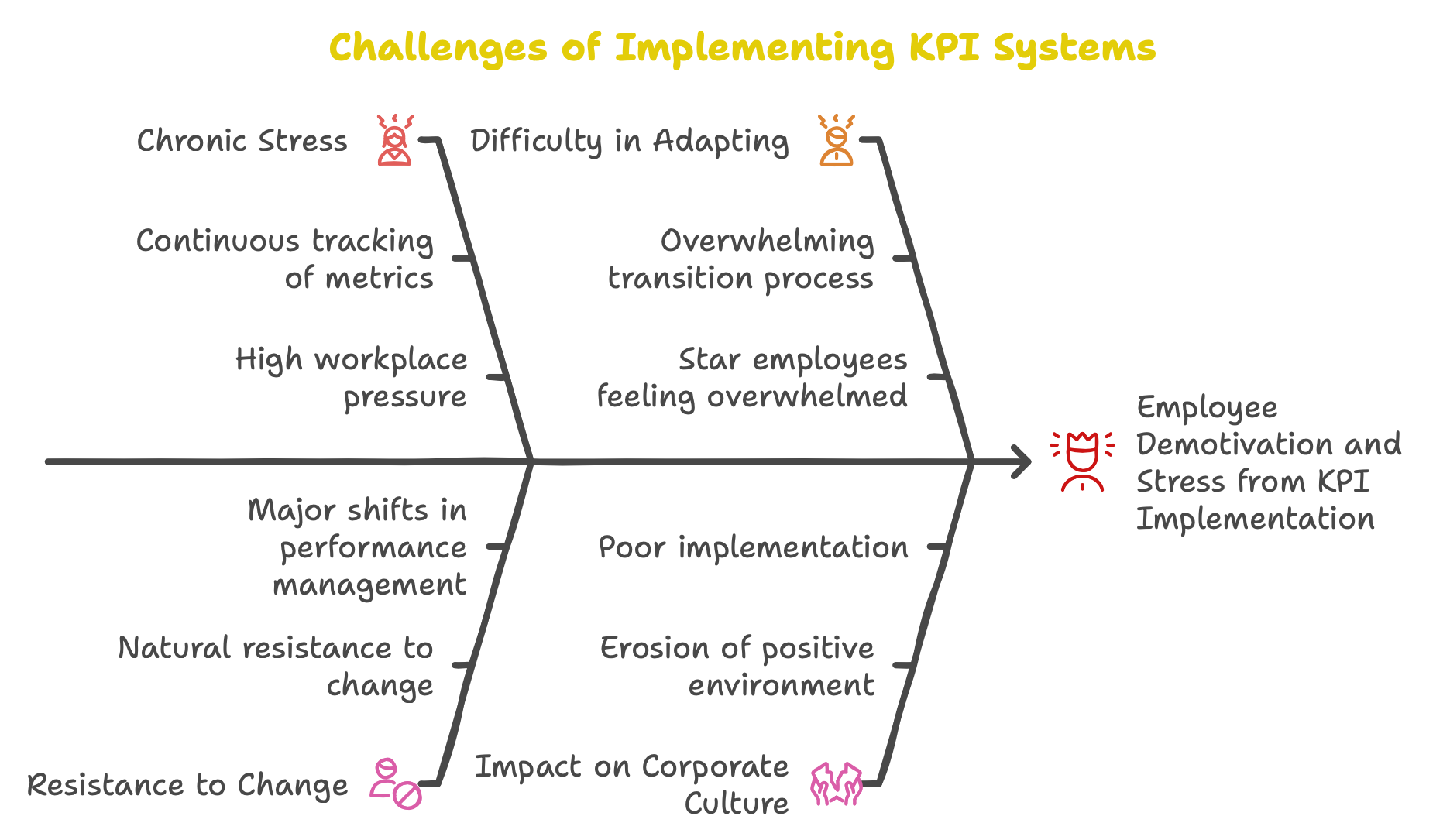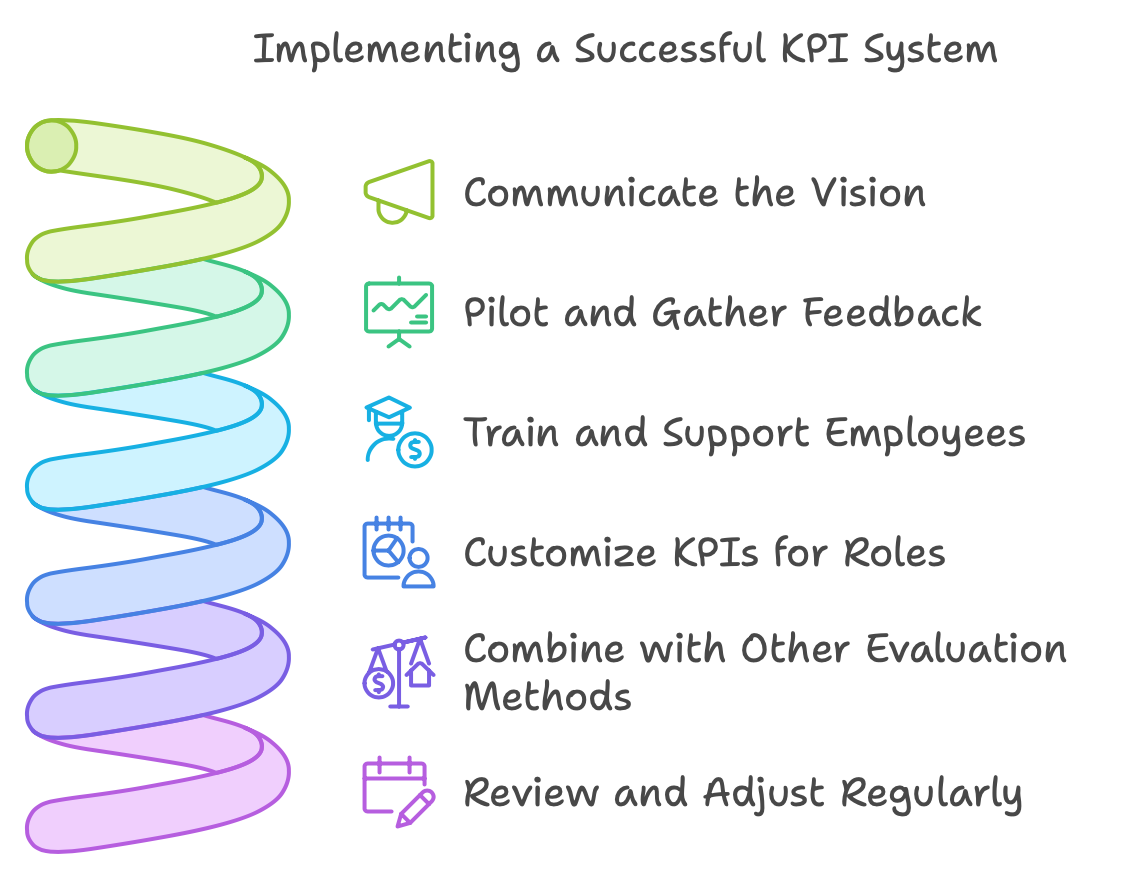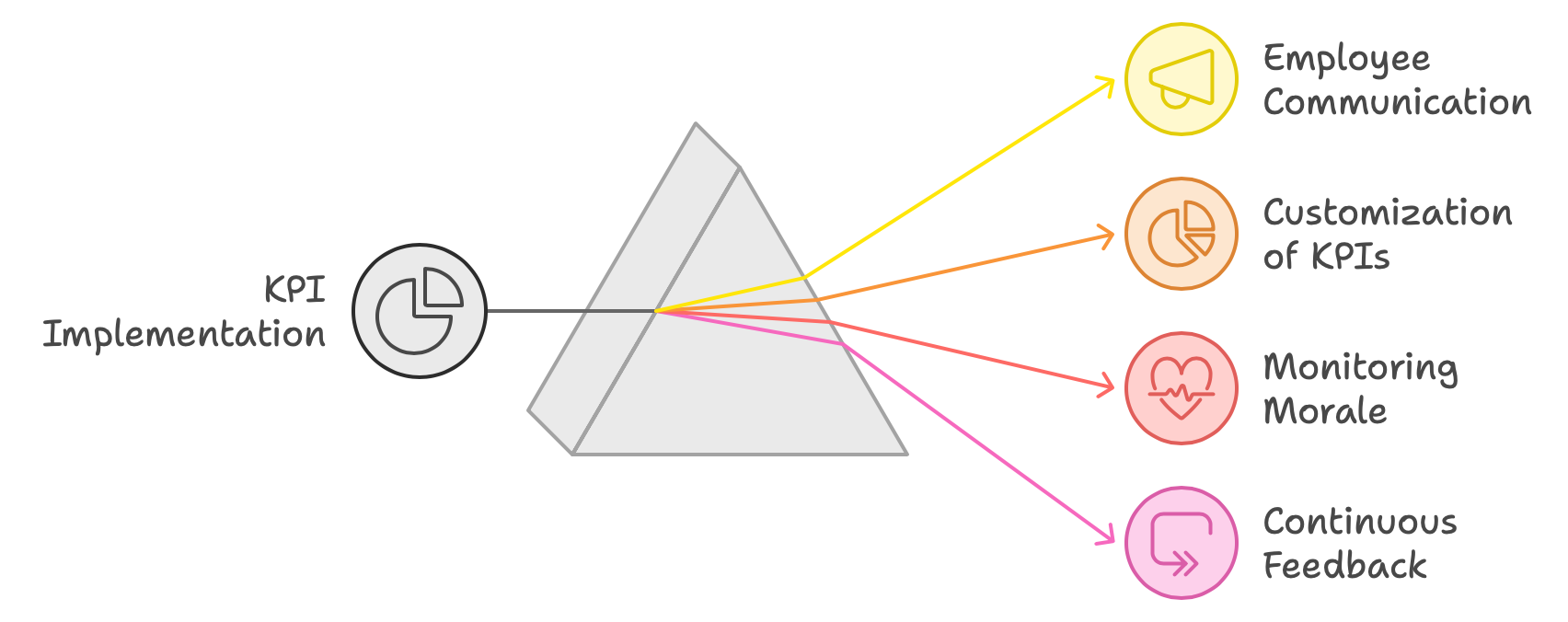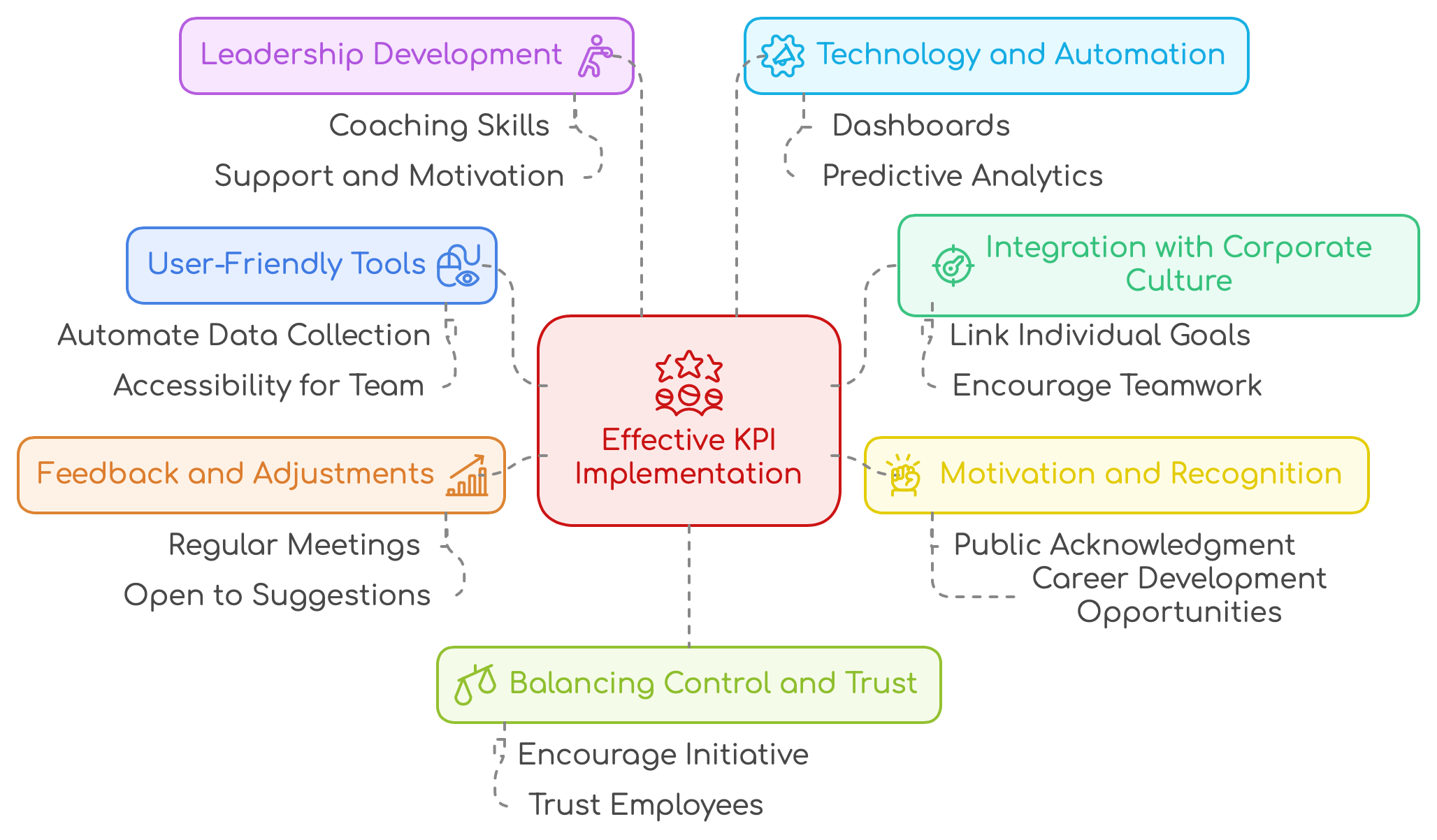How to Retain Employees While Implementing a KPI System
In today’s world of data, charts, and metrics, implementing a KPI system sounds like the ultimate strategic move. After all, who wouldn’t want clear, measurable indicators of success?
But if only you knew how many businesses have stumbled on this path... Yes, the journey of implementing Key Performance Indicators (KPIs) is one many companies take, hoping to secure their position in the market.
However, reality can be harsh: introducing KPIs can lead to the loss of your best employees if not handled correctly.
Let’s dig into how to avoid this and strike the right balance between efficiency and retaining your key people. I also recommend you to read an article about importance of teams efficiency - The Real Reasons Projects Stall - and How Better HR, Planning, and Communication Can Fix Them
But if only you knew how many businesses have stumbled on this path... Yes, the journey of implementing Key Performance Indicators (KPIs) is one many companies take, hoping to secure their position in the market.
However, reality can be harsh: introducing KPIs can lead to the loss of your best employees if not handled correctly.
Let’s dig into how to avoid this and strike the right balance between efficiency and retaining your key people. I also recommend you to read an article about importance of teams efficiency - The Real Reasons Projects Stall - and How Better HR, Planning, and Communication Can Fix Them
Why Does Implementing KPIs Lead to Losing Employees?

Chronic Stress: Continuous tracking of performance metrics can make the workplace feel like a pressure cooker. The tension doesn’t just affect people—soon, even the coffee machine seems stressed.
Resistance to Change: People are naturally resistant to change, especially when it comes to their work. Implementing a KPI system often represents a major shift in how performance is viewed and managed.
Difficulty in Adapting: The transition to a new system can be overwhelming. Even your star employee might feel the urge to escape to the mountains if the process feels too daunting.
Impact on Corporate Culture: Drastic changes can shake the company’s established culture. A KPI system, if implemented poorly, can erode the close-knit, positive environment your company took years to build.
Demotivation: When the KPI structure is misaligned or poorly designed, don’t expect glowing reviews. We've all seen the look of defeat in a colleague who feels they’re no longer appreciated or recognized.
I addition to that read our article The Thinking Crisis in Organizations: Why We Don’t Think as We Should
Resistance to Change: People are naturally resistant to change, especially when it comes to their work. Implementing a KPI system often represents a major shift in how performance is viewed and managed.
Difficulty in Adapting: The transition to a new system can be overwhelming. Even your star employee might feel the urge to escape to the mountains if the process feels too daunting.
Impact on Corporate Culture: Drastic changes can shake the company’s established culture. A KPI system, if implemented poorly, can erode the close-knit, positive environment your company took years to build.
Demotivation: When the KPI structure is misaligned or poorly designed, don’t expect glowing reviews. We've all seen the look of defeat in a colleague who feels they’re no longer appreciated or recognized.
I addition to that read our article The Thinking Crisis in Organizations: Why We Don’t Think as We Should
How to Retain Employees During KPI Implementation

Effective Communication: Above all, talk to your people! Explain why the KPI system is necessary and what future successes it’s expected to bring. People need clarity about what lies ahead. Host open meetings where employees can voice concerns, ask questions, and understand the roadmap—this is essential for a smooth rollout.
Gradual Rollout: Remember the adage about eating an elephant one bite at a time? The same applies here. Try a pilot program in a single department first. Gather feedback on what worked and what didn’t, and only then scale the initiative. Feedback is crucial, so don’t skip this step.
Training and Support: No one is born with the ability to master KPIs in their sleep. Provide training for your staff. Ensure they have the tools they need to succeed and establish a support group that can answer questions as they arise.
Individual Approach: Each employee is unique, and a one-size-fits-all KPI system won’t work. A marketer may find it easier to adapt than an accountant, or vice versa. Tailor the KPIs to the specific roles, ensuring that creative, technical, or hard-to-measure tasks aren’t judged by inappropriate metrics.
Balanced Evaluation Methods: KPIs are not a magic solution. Combine them with other assessment methods that consider qualitative aspects of performance, such as peer reviews and customer feedback.
Regular Revisions: KPIs should be a living system, not something set in stone. Regularly review and adjust the KPIs, particularly if some metrics are failing or are negatively impacting morale.
Gradual Rollout: Remember the adage about eating an elephant one bite at a time? The same applies here. Try a pilot program in a single department first. Gather feedback on what worked and what didn’t, and only then scale the initiative. Feedback is crucial, so don’t skip this step.
Training and Support: No one is born with the ability to master KPIs in their sleep. Provide training for your staff. Ensure they have the tools they need to succeed and establish a support group that can answer questions as they arise.
Individual Approach: Each employee is unique, and a one-size-fits-all KPI system won’t work. A marketer may find it easier to adapt than an accountant, or vice versa. Tailor the KPIs to the specific roles, ensuring that creative, technical, or hard-to-measure tasks aren’t judged by inappropriate metrics.
Balanced Evaluation Methods: KPIs are not a magic solution. Combine them with other assessment methods that consider qualitative aspects of performance, such as peer reviews and customer feedback.
Regular Revisions: KPIs should be a living system, not something set in stone. Regularly review and adjust the KPIs, particularly if some metrics are failing or are negatively impacting morale.
Psychological Aspects of KPI Implementation
Fear, Unfairness, Loss of Autonomy: These are the three major psychological challenges employees face when a new KPI system is introduced.
- Fear of Failure: Employees may fear that they won’t meet the targets, leading to anxiety. Providing continuous, constructive feedback will help alleviate this fear.
- Fairness: Ensure the KPI system is perceived as fair. If employees think the system is skewed or biased, they’ll lose trust in it and, by extension, in the company.
- Autonomy: Give employees a voice in setting their targets. This sense of ownership helps them feel more invested and less like they’re being micromanaged.
The Role of HR in Retaining Employees During KPI Implementation

As HR, we are the driving force behind a successful KPI rollout. Our role goes beyond administration—we shape the experience for employees, ensuring the system helps them thrive, not feel overwhelmed. Here’s how we can make sure that happens:
Assess Organizational Readiness
First, we need to analyze if the company is ready for KPIs. This includes evaluating current workflows, gauging employee attitudes toward change, and ensuring we have the right tools and technology in place. We also need to check if leadership is fully aligned and prepared to support the shift.
Create a Clear Communication and Training Plan
It’s our job to communicate the "why" behind the KPIs clearly. We need to break down the system so that everyone understands it, not just managers. We should organize training sessions to equip employees with the skills to handle KPIs and make sure managers are ready to support their teams through the change.
Monitor Morale During the Transition
As KPIs are introduced, we must keep a close eye on employee sentiment. Setting up feedback channels and conducting regular check-ins will help us catch any signs of frustration early on. By monitoring morale and productivity data, we can address issues before they turn into bigger problems.
Customize KPIs for Different Roles
We know that KPIs can't be one-size-fits-all. We should work with managers to tailor KPIs to the unique needs of each department and role, ensuring they accurately reflect what employees do. It’s also important to involve employees in setting their goals, so they feel ownership and aren’t just following top-down metrics.
Facilitate Continuous Feedback and Adjustments
Our job doesn’t stop after implementation. We need to set up ongoing reviews of the KPI system, gathering feedback and making adjustments where necessary. Encouraging flexibility and celebrating small wins will help keep employees motivated and invested in the process.
By leading with clear communication, customization, and continuous support, we can ensure the KPI system strengthens our teams rather than causes unnecessary stress.
First, we need to analyze if the company is ready for KPIs. This includes evaluating current workflows, gauging employee attitudes toward change, and ensuring we have the right tools and technology in place. We also need to check if leadership is fully aligned and prepared to support the shift.
Create a Clear Communication and Training Plan
It’s our job to communicate the "why" behind the KPIs clearly. We need to break down the system so that everyone understands it, not just managers. We should organize training sessions to equip employees with the skills to handle KPIs and make sure managers are ready to support their teams through the change.
Monitor Morale During the Transition
As KPIs are introduced, we must keep a close eye on employee sentiment. Setting up feedback channels and conducting regular check-ins will help us catch any signs of frustration early on. By monitoring morale and productivity data, we can address issues before they turn into bigger problems.
Customize KPIs for Different Roles
We know that KPIs can't be one-size-fits-all. We should work with managers to tailor KPIs to the unique needs of each department and role, ensuring they accurately reflect what employees do. It’s also important to involve employees in setting their goals, so they feel ownership and aren’t just following top-down metrics.
Facilitate Continuous Feedback and Adjustments
Our job doesn’t stop after implementation. We need to set up ongoing reviews of the KPI system, gathering feedback and making adjustments where necessary. Encouraging flexibility and celebrating small wins will help keep employees motivated and invested in the process.
By leading with clear communication, customization, and continuous support, we can ensure the KPI system strengthens our teams rather than causes unnecessary stress.
Technical Aspects

User-Friendly Tools: Use tools that track KPIs without turning your employees into IT experts. Automate data collection where possible and make information accessible to everyone on the team.
Integration with Corporate Culture: KPIs should reflect your company’s core values. Encourage teamwork by linking individual performance goals with overall company objectives. Build a culture of growth around the KPI system.
Motivation and Recognition: Develop a reward system that recognizes achievements beyond just financial incentives. Public acknowledgment and non-monetary rewards, such as opportunities for career development or extra vacation days, can go a long way in keeping morale high.
Feedback and Adjustments: Hold regular meetings to discuss progress and challenges. Be open to suggestions and be willing to tweak KPIs if they prove to be unrealistic or demotivating.
Leadership Development: Equip your managers with the skills to coach their teams effectively in a KPI-driven environment. Leaders should be able to provide guidance, support, and motivation as their teams adapt to the new system.
Technology and Automation: Leverage technology to make KPI tracking easier. Dashboards and predictive analytics can help managers and employees alike see trends, make informed decisions, and focus on areas that need improvement without being overwhelmed by manual data crunching.
Balancing Control and Trust. Find a healthy balance between tracking performance and trusting your employees to deliver results. Encourage initiative and creativity, and ensure that employees don’t feel they’re being watched over every minute of the day.
Integration with Corporate Culture: KPIs should reflect your company’s core values. Encourage teamwork by linking individual performance goals with overall company objectives. Build a culture of growth around the KPI system.
Motivation and Recognition: Develop a reward system that recognizes achievements beyond just financial incentives. Public acknowledgment and non-monetary rewards, such as opportunities for career development or extra vacation days, can go a long way in keeping morale high.
Feedback and Adjustments: Hold regular meetings to discuss progress and challenges. Be open to suggestions and be willing to tweak KPIs if they prove to be unrealistic or demotivating.
Leadership Development: Equip your managers with the skills to coach their teams effectively in a KPI-driven environment. Leaders should be able to provide guidance, support, and motivation as their teams adapt to the new system.
Technology and Automation: Leverage technology to make KPI tracking easier. Dashboards and predictive analytics can help managers and employees alike see trends, make informed decisions, and focus on areas that need improvement without being overwhelmed by manual data crunching.
Balancing Control and Trust. Find a healthy balance between tracking performance and trusting your employees to deliver results. Encourage initiative and creativity, and ensure that employees don’t feel they’re being watched over every minute of the day.
Conclusion and Thoughts
Introducing a KPI system doesn’t have to feel like a survival game for your employees. The primary goal of KPIs should be growth and development, not strict control. Build a culture where KPIs are seen as tools for progress, and you’ll not only avoid losing your top talent but also strengthen their motivation and loyalty.
The key to successful KPI implementation lies in how you balance measurement with human factors. The most sophisticated system won’t work if it alienates or demotivates your employees. The focus should be on empowerment, clarity, and fairness. A gradual, inclusive process, supported by ongoing communication, will turn KPIs from a potential source of stress into a tool for progress. Leadership, empathy, and adaptability are critical to ensuring this. By fostering a supportive environment, you can turn KPIs into a powerful driver for success without sacrificing the well-being and loyalty of your team.
I also recommend you to read related articles:
How Tailored HR Services Helping to Increase Organisational Efficiency
Transformative Potential of Hybrid Organizational Structures
Digital transformation is the way how to increase productivity
Transformation to cross-functional teams
The key to successful KPI implementation lies in how you balance measurement with human factors. The most sophisticated system won’t work if it alienates or demotivates your employees. The focus should be on empowerment, clarity, and fairness. A gradual, inclusive process, supported by ongoing communication, will turn KPIs from a potential source of stress into a tool for progress. Leadership, empathy, and adaptability are critical to ensuring this. By fostering a supportive environment, you can turn KPIs into a powerful driver for success without sacrificing the well-being and loyalty of your team.
I also recommend you to read related articles:
How Tailored HR Services Helping to Increase Organisational Efficiency
Transformative Potential of Hybrid Organizational Structures
Digital transformation is the way how to increase productivity
Transformation to cross-functional teams
UnitiQ can help with implementing KPIs
At UnitiQ, we help businesses implement KPIs smoothly without overwhelming their teams. Through our fractional HR and talent management expertise, we guide companies step-by-step, ensuring KPIs are introduced in a way that empowers employees rather than stresses them out. We focus on tailored communication, customized metrics for different roles, and ongoing support to keep morale high. By managing both the technical and human aspects of KPI integration, we make sure our clients see improved performance without sacrificing employee motivation or well-being. With UnitiQ, introducing KPIs becomes a path to growth, not frustration.
Contact me today for a free consultation, and let’s work together to set your business up for long-term success!
My Telegram
My LinkedIn
Contact me today for a free consultation, and let’s work together to set your business up for long-term success!
My Telegram
My LinkedIn
